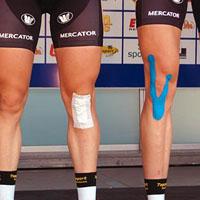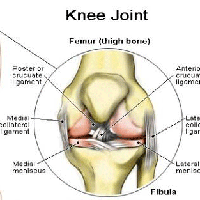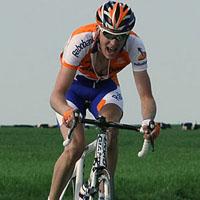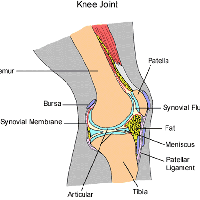
Recently on Cyclingnews.com |
April 24, 2009
What you need to know about knees

|
Cycling is often touted as a recreation where participants can avoid the injuries common in other sports, such as knee pain. For some riders this isn't the case however, and ailments to the knees occur due to a combination of factors. Dr Giles P Croft explains how to recognise these factors and what you can do about them.
Professional riders such as Rabobank's Robert Gesink can experience knee ailments; the Dutchman finished third in last Sunday's Amstel Gold Race but had to miss the mid-week Classic Flèche Wallonne due to a knee complaint. But what causes these problems?
Knee conditions can be generally divided into three broad categories: cycling-specific, bike-specific and cyclist-specific. Specific overuse injuries usually arise from a combination of factors across all these three domains - the secret is to identify which is contributing the greatest offence and make a focused change for the better.
Cycling-specific
Unfortunately, our cycling enthusiasm is to blame for one of the most common causes of knee pain. You know the story - new season, new goals, a change in the weather or maybe a new bike. With renewed vigour we resolve to cast off the winter's sloth and get down to some serious riding - with scant regard for how our knees might bear up to the onslaught.
'No pain, no gain' only holds true within certain limits. It's no surprise that new studies cite lack of pre-ride conditioning as a risk factor for injury. Drastically increasing anything to do with our riding habits - distance, speed, intensity, tough terrain or tough gears - without gradual acclimatisation is just asking for trouble. That envelope of function is exceeded, and damage accumulates until the forces through the knee joint are reduced.
Even changing from long, steady winter base training to shorter, sharper rides in the early season can precipitate problems; if the body's not used to a specific type of training, it's interpreted as a drastic change.
Get involved
|
Cycling-Specific Causes: Changes in training that exceed the body's capacity for normal function and repair
* Greatly increasing distance and duration of rides
* Sudden increase in training intensity
* Riding more hills than usual
* Using high gears and low cadence
Bike-specific
The same basic principle applies here; if radical changes are made to equipment and position, problems will very likely arise.
The key measurements affecting the knee are saddle height and setback, with crank length affecting not only the absolute saddle-to-pedal distance, but also the force required to generate one full pedal revolution. Longer cranks (essentially the equivalent to using stiffer gears) increase the forces transmitted across the patellofemoral joint (explained below) thus amplifying the likelihood of cumulative damage.
The patellofemoral joint - or 'PFJ' - comprises:* Femur - the thigh bone, the biggest bone in the body,
with the hip joint at one end and the knee at the other |
If you're new to cycling, or to a particular bike, a lack of frame of reference can mean it's sometimes difficult to establish exactly where the problem might lie. There's no universally agreed correct way to set your bike up, but most reputable bike shops will provide advice, with some offering an adjustable bike-fit jig and several decades of experience.
Bike-Specific Causes: Changes in equipment or a position on the bike that the body's not used to
* Saddle height and saddle setback
* Length of cranks
* Cleat position or excessive wear
Cyclist-specific
This refers to our own individual biomechanics and make-up - they are intrinsic causes, rather than extrinsic. As such they often manifest quite stealthily, contributing to the two categories above, such that our training load reaches a particular threshold, at which point we are suddenly troubled with knee pain.

|
Anatomical differences, such as leg length discrepancies, may contribute to problems in one particular leg, but in reality we all favour one leg over the other (it's the one with the thigh closest to the seat post when pedaling), in part explaining why knee pain seldom affects both legs equally.
Each individual's body has also had to respond to a lifetime's knocks, scrapes and more serious injuries, which it does by moving in subtly different ways, initially to protect the injury, and then, once healed, because it's got used to these new movements as being normal.
Damage to your knee could be caused by you, your bike or the way you cycle: damage to your knee could be caused by you, your bike or the way you cycle
But the cumulative effect of all of these can upset the fine balance of forces
the knee has to deal with. This dissipation or 'coping' with energy
transmitted through the joint is done largely by the muscles and their tendons,
so it stands to reason that tight, inelastic muscles can indirectly contribute
to increased forces through the PFJ.
Summary of causes of knee overuse injury.
Cyclist-Specific Causes: Biomechanical (intrinsic) abnormalities that compound cycling- and bike-specific causes
* Anatomical discrepancies (e.g. leg length)
* Legacy of old injuries
* Inflexibility & muscle tightness
* Muscle weakness (including core muscles)
Cycling-specific solutions

|
These involve unloading the problem area, most often the PFJ. This means easing back on your training until you've redressed the balance. Carrying on blithely, hoping it will go away is only likely to set you up for longer term problems.
This isn't to say you have to stop riding entirely. Only you can know what you're capable of, but a rule of thumb is to exercise painlessly as much as possible. Lower distances, fewer hills and lower gears can all help you maintain fitness without destroying your knees, while you make concurrent changes across the other two domains.
Of course, prevention is far better than cure, so make only gradual increases to your training (no more than 10-15 percent more each week) and watch out for the transition between low and high intensity where hours may remain static (or even decrease), masking a sudden change to training. Keeping a diary of your rides is essential to get to the bottom of this type of problem.
Bike-specific solutions
Again these revolve around making small changes when they are required in order to prevent problems from occurring in the first place.
Always note down the measurement of anything before changing a component: saddle height, setback and cleat position (the easiest way is to draw round the old ones with a felt tip pen before removing them).
Cleats with 'float' (small amounts of rotation when engaged) are a good idea, and consider swapping those super-long cranks for a pair of 170mm ones.
Cyclist-specific solutions
These are possibly the trickiest to tackle. Having said this, general measures such as hot baths to loosen tight muscles, followed by regular stretching of large muscle groups (quads, hamstrings, adductors and gluteal muscles) can increase flexibility to cope better with pressures across the PFJ.
Specific stretches for specific problems will be tackled next time, but the practice of pre-ride stretching has not been shown to reduce the likelihood of picking up an overuse injury. This further reinforces the message that vigorous stretching of cold muscles is at best ineffectual and at worst potentially damaging.
The role of core muscles should also not be overlooked – the abdominal,
back and especially pelvic muscles all contribute to taking the strain off the
major leg muscles.
How do knee problems occur?
This requires a basic explanation of the anatomy and biomechanics of the knee. In simple terms the knee is a hinge joint between the femur (thigh bone) and the tibia (shin bone), acted upon by the large muscles of the thigh.
At the back, the hamstrings flex the knee, as well as helping the gluteal muscles to extend the hip joint. At the front, the quadriceps extend or straighten the knee by attaching to the tibia via your patella (the kneecap). This has its own articulation with the thigh bone - the patellofemoral joint, or 'PFJ' - which often plays a lead role where knee pain is concerned, since bending the knee compresses the joint.
Looking at knee pain structurally

|
Those 'large muscles of the thigh' can get very large with regular two-wheeled activity, and this is where problems start.
The normal movements of the knee are finely balanced, and with different muscle groups pulling at the patella from slightly different angles, it doesn't take much to upset things. Add to this tight muscles restricting normal motion, varying saddle heights and feet firmly planted in angled cleats, and it's amazing we don't all cycle with fixed grimaces.
Every pedal stroke flexes and extends the knee joint, yet never fully extends it. The powerful push (extending) phase starts with the knee flexed to around 110 degrees, reaching about 35 degrees before flexing back through the pull phase. It can all add up to years of relative imbalance between those powerful muscle groups and unnatural forces about the knee.
Who suffers from overuse knee pain?
Overuse injuries arise from repetition. The accumulation of excessive loads over time exceed the body's ability to dissipate energy, leading to damage on a microscopic level which, if not given chance to recover, sets up a chronic cycle of improperly healed inflammation and tissue degeneration, experienced as pain, weakness and stiffness.
What else can be done about knee pain?
It sounds awful, but the good news is the vast majority of these injuries improve with simple non-operative interventions, the key being to rehabilitate within the boundaries of the body's natural capacity for repair, or what's been termed the 'envelope of function' in the Sports Medicine & Arthroscopy Review.
Whatever the nature of your knee pain, it's crucial to listen to your body and react accordingly. Occasional pain while on the bike means you're just outside the limits of your body's capacity for repair. Consequently, any adjustments needed are likely to be minimal, with little upset to your training. On the other hand, pain that's present every time you cycle and persists when you're off the bike implies your body's crying out for respite.
You may wish to enlist the help of a physiotherapist - those within the specialties of sports and manipulative physiotherapy - and it's worth remembering that family doctors are generalists but many have a specialist interest. Ask at your local practice whether one of the GPs has an interest in musculo-skeletal and/or sports medicine - they may even run a specialist clinic at your practice.
